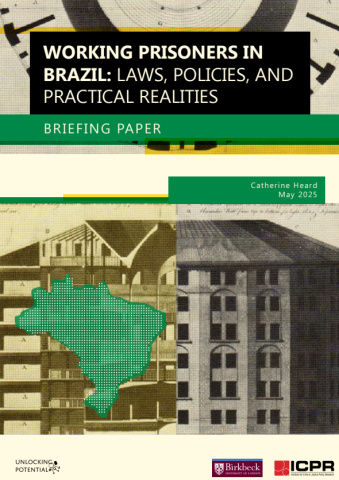
The law, policy and practice of prison work provision in Brazil are explained in a new briefing by the Institute for Crime & Justice Policy Research.
‘Working prisoners in Brazil: laws, policies and practical realities’ begins with an account of the extraordinary growth this country’s prison population has seen in recent decades. In the mid- 1980s when Brazil’s military dictatorship ended and new federal legislation was introduced to regulate prisoners’ daily lives—including work and training—the country’s prison population was one-tenth of the size it is today. As Brazil’s custodial population grew, investment in buildings, facilities and staff lagged behind, unable to keep up with the ever-greater demand caused by an increasingly hard-line approach to crime.
Brazil’s prison population is young and overwhelmingly in the working age bracket: almost 60% of those in custody are aged between 18 and 34: fewer than 3% are over 60. The most common offences prisoners have been convicted of are property-related (37% of offences), followed by drug offences (29%). The make-up of the prison population reflects Brazil’s wider structural inequalities, with 64% of prisoners being Black or mixed race, compared to 52% of the total population.
Prisoners’ right to paid, productive, educative work is enshrined in law – but work is often scarce and unpaid
For most prison administrations, the focus is on containing violence and organized criminality in prisons rather than resocialising people through work and training as the law requires. In some parts of the country, opportunities to work in prison barely exist, whereas in others, an increased policy focus and greater investment in staff and infrastructure have led to higher levels of work and training. To highlight and explain these regional disparities, the briefing concentrates on three states (São Paulo, Santa Catarina and Maranhão), exploring the ways in which they resemble or are distinct from the national picture in terms of the types and amounts of prison work reported.
Federal law requires every sentenced prisoner to work to the extent of their capacity and aptitude. Work should have ‘educative and productive purposes’, and prison work is described as ‘a condition of social dignity’. Work is also a right—as is being paid for the work done. The law states that working prisoners must be paid no less than three-quarters of the national statutory minimum wage (equating to about US$ 160 per month). But in fact over 60% of all prison work is either unpaid or paid below this minimum.
Sentence remission a bigger incentive to work than pay
A further right for all working prisoners—and, given the uneven implementation of the minimum prison wage, often the main incentive for working—is sentence remission. Prisoners are entitled to remission of one day off their sentence for every three days worked. This not only motivates prisoners to work: it is also seen as an important tool for prison managers to control overcrowding.
Work levels increasing, but most work is in ‘prison services’
Government policies have placed increasing focus on getting more prisoners working, and on more prison-leavers accessing the job market. Our analysis shows that just over a quarter of all prisoners in custody were reported to have been working in the second half of 2024: the highest number since records began in 2016.
Prisons themselves are the main provider, rather than outside companies or other partners; over half of the jobs prisoners do are in ‘prison services’, covering cleaning, maintenance, and similar tasks. This work may be preferable to life in cramped, often dangerous communal cells; and it earns remission. But will it equip people with the skills needed for decent jobs on release – or does it just entrench inequalities in the wider economy? In Brazil as a whole, around 40% of workers are engaged in informal or subsistence labour, doing low paid manual jobs in construction, textiles, domestic or janitorial services and agriculture. As in the custodial population, where these types of work predominate, the workforce are more likely to be Black and to have had limited access to education and skills training.
Next steps
This is the last in a series of country briefings on prison work across the UK, the USA and Brazil, from our comparative project, ‘Unlocking potential: towards effective, sustainable and ethical provision of work opportunities for prisoners and prison leavers’. More information on the project can be found here
Our next round of publications will be a set of case studies describing how work is provided and experienced in six prisons in England, Brazil and the USA, following fieldwork at various prison sites over the course of this project.
‘Working prisoners in Brazil: laws, policies and practical realities’ can be accessed here.